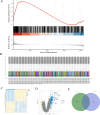Exploring ferroptosis-associated immune characteristics in Kawasaki disease through bioinformatics
- PMID: 40825967
- PMCID: PMC12361573
- DOI: 10.1038/s41598-025-15182-7
Exploring ferroptosis-associated immune characteristics in Kawasaki disease through bioinformatics
Abstract
Kawasaki disease (KD), as a common pediatric inflammatory vasculitis, has an unclear pathogenesis. This study integrated bioinformatics and clinical data analysis to explore the characteristics of ferroptosis in KD. We used data from the Gene Expression Omnibus (GEO) database to identify ferroptosis-related genes, and variable selection was performed using Least Absolute Shrinkage and Selection Operator (LASSO) analysis. We employed seven machine learning methods to determine the optimal predictive model, revealing that the Support Vector Machine (SVM) model exhibited optimal performance in external validation. Unsupervised clustering based on FRGs stratified KD patients into high and low expression subtypes. The high expression subtype showed significantly elevated levels of monocyte immune infiltration, which was further validated by single-cell analysis. Clinical data analysis demonstrated that patients in the high-monocyte group not only had a higher incidence of incomplete KD presentations but also exhibited lower resistance to intravenous immunoglobulin (IVIG) therapy. These results suggest that ferroptosis may participate in the pathogenesis of KD by modulating monocyte levels, providing new insights into explaining clinical heterogeneity and differences in IVIG treatment responses.
Keywords: Clinical data analyses; Ferroptosis; Immune infiltration; Kawasaki disease; Machine learning; Molecular clusters; Single-cell analysis.
© 2025. The Author(s).
Conflict of interest statement
Declarations. Competing interests: The authors declare no competing interests. Consent for publication: Not applicable. Ethical approval and consent to participate: The clinical data research was conducted in accordance with the Declaration of Helsinki and approved by the Ethics Committee of the Affiliated Hospital of Southwest Medical University. The committee also granted a waiver of informed consent since the retrospectively collected data were anonymized (Luzhou, China; Approval No. KY2025177). The gene dataset was obtained from a public database, and therefore no additional ethics committee approval or patient consent was required.
Figures










References
-
- McCrindle, B. W. et al. Diagnosis treatment, and long-term management of Kawasaki disease: A scientific statement for health professionals from the American heart association. Circulation135(17), e927–e999 (2017). - PubMed
-
- Kawasaki, T., Kosaki, F., Okawa, S., Shigematsu, I. & Yanagawa, H. J. P. A new infantile acute febrile mucocutaneous lymph node syndrome (MLNS) prevailing in Japan. Pediatrics54(3), 271–276 (1974). - PubMed
-
- McCrindle, B. W. et al. Diagnosis, treatment, and long-term management of Kawasaki disease: A scientific statement for health professionals from the American heart association. Circulation135(17), e927–e999 (2017). - PubMed
MeSH terms
Substances
Grants and funding
LinkOut - more resources
Full Text Sources
Medical

